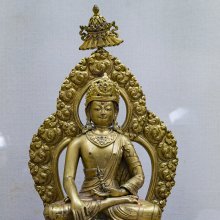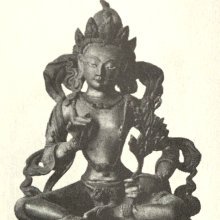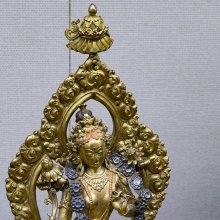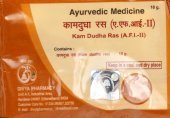Ka, Kā: 24 definitions
Introduction:
Ka means something in Buddhism, Pali, Hinduism, Sanskrit, the history of ancient India, Marathi, Hindi, biology, Tamil. If you want to know the exact meaning, history, etymology or English translation of this term then check out the descriptions on this page. Add your comment or reference to a book if you want to contribute to this summary article.
Images (photo gallery)
(+8 more images available)
In Hinduism
Purana and Itihasa (epic history)
Source: archive.org: Puranic Encyclopedia1) Ka (क).—This letter has the following meanings:
(i) Prajāpati. (Śloka 32, Chapter 1, Ādi Parva, Mahābhārata)
(ii) A name of Dakṣaprajāpati. (Śloka 7, Chapter 208, Śānti Parva, Mahābhārata).
(iii) A name of Viṣṇu. (Śloka 91, Chapter 149, Anuśāsana Parva, Mahābhārata)
(iv) Brahmā (Viṣṇu, Maheśvara). (Chapter 348, Agni Purāṇa, Mahābhārata).
2) Ka (क).—ĀDA. A famous sage of ancient India. He was the founder of the Vaiśeṣika system. The word means one who eats Kaṇa (atom). His foes gave him this name to ridicule him. He is also called Kaṇabhakṣaka. Kaṇāda is known as Pippalāda also. (He got that name because he used to eat Pippalī (long pepper) in large quantities). (See under PIPPALĀDA).
Source: Cologne Digital Sanskrit Dictionaries: The Purana Index1a) Ka (क).—The Lord of Creatures: The Great Puruṣa.*
- * Bhāgavata-purāṇa II. 1. 32; III. 6. 19; VIII. 5. 39; Vāyu-purāṇa 4. 43.
1b) A name of Brahmā.*
- * Bhāgavata-purāṇa X. 13. 18; 14. 2; 85. 47.

The Purana (पुराण, purāṇas) refers to Sanskrit literature preserving ancient India’s vast cultural history, including historical legends, religious ceremonies, various arts and sciences. The eighteen mahapuranas total over 400,000 shlokas (metrical couplets) and date to at least several centuries BCE.
Vyakarana (Sanskrit grammar)
Source: Wikisource: A dictionary of Sanskrit grammarKa (क).—(l) tad.affix क (ka) applied to the words of the ऋश्य (ṛśya) group in the four senses called चातुरर्थिक (cāturarthika) e. g. ऋश्यकः, अनडुत्कः, वेणुकः (ṛśyakaḥ, anaḍutkaḥ, veṇukaḥ) etc., cf. P.IV.2.80; (2) tad. affix क (ka) applied to nouns in the sense of diminution, censure, pity etc. e. g. अश्वक्रः, उष्ट्रकः, पुत्रकः (aśvakraḥ, uṣṭrakaḥ, putrakaḥ), cf. P.V. 3.70-87: (3) tad. affix क (ka) in the very sense of the word itself (स्वार्थे (svārthe)) e.g. अविकः, यावकः, कालकः (avikaḥ, yāvakaḥ, kālakaḥ); cf. P.V.4.28-33; (4) Uṇādi affix क (ka) e.g. कर्क, वृक, राका, एक, भेक, काक, पाक, शल्क (karka, vṛka, rākā, eka, bheka, kāka, pāka, śalka) etc. by Uṇādi sūtras III. 40-48 before which the angment इट् (iṭ) is prohibited by P. VII.2.9; (5) kṛt affix क (ka) (अ) where क् (k) is dropped by P. I. 3.8, applied, in the sense of agent, to certain roots mentioned in P.III.1.135, 136, 144, III. 2.3 to 7, III.2.77 and III.3.83 e.g. बुधः, प्रस्थः, गृहम्, कम्बलदः, द्विपः, मूलविभुजः, सामगः, सुरापः (budhaḥ, prasthaḥ, gṛham, kambaladaḥ, dvipaḥ, mūlavibhujaḥ, sāmagaḥ, surāpaḥ) etc.; (6) substitute क (ka) for the word किम् (kim) before a case affix, cf. P.VII.2.103; (7) the Samāsānta affix कप् (kap) (क) at the end of Bahuvrīhi compounds as prescribed by P.V.4.151-160.
--- OR ---
Kā (का).—A technical term used in the Jainendra Vyākaraṇa for the term पञ्चमी (pañcamī) used in Pāṇini's grammar.

Vyakarana (व्याकरण, vyākaraṇa) refers to Sanskrit grammar and represents one of the six additional sciences (vedanga) to be studied along with the Vedas. Vyakarana concerns itself with the rules of Sanskrit grammar and linguistic analysis in order to establish the correct context of words and sentences.
Jyotisha (astronomy and astrology)
Source: Wisdom Library: Brihat Samhita by VarahamihiraKa (क) or Kaketu refers to a particular type of Ketus (i.e., luminous bodies such as comets and meteors), according to the Bṛhatsaṃhitā (chapter 11), an encyclopedic Sanskrit work written by Varāhamihira mainly focusing on the science of ancient Indian astronomy astronomy (Jyotiṣa).— Accordingly, “Śveta Ketu is a comet which appears in the east about midnight with its tail pointing to the south. Ka Ketu is a comet of the shape of a carriage pole and appears in the west. Both the above Ketus are seen simultaneously for 7 days. If both should appear glossy, there will be prosperity and happiness in the land; if the Ka Ketu should be visible for over 7 days, there will be much suffering from wars for ten years”.

Jyotisha (ज्योतिष, jyotiṣa or jyotish) refers to ‘astronomy’ or “Vedic astrology” and represents the fifth of the six Vedangas (additional sciences to be studied along with the Vedas). Jyotisha concerns itself with the study and prediction of the movements of celestial bodies, in order to calculate the auspicious time for rituals and ceremonies.
Shaktism (Shakta philosophy)
Source: Brill: Śaivism and the Tantric Traditions (shaktism)Kā (का) is another name for Goddess Nityā, according to the King Vatsarāja’s Pūjāstuti called the Kāmasiddhistuti (also Vāmakeśvarīstuti), guiding one through the worship of the Goddess Nityā.—Accordingly, “[...] O mother! Even the kings of gods bow to the feet of those men who have acquired a drop of the grace of seeing you. [...] Mindful men call you Kledanī, Kulakuṇḍalinī, Kā, Nityā, Nīti, Nau, Nāvikā, Vidyā, Saṃvid, Vīśvamayī, Umā, Kāmeśvarī, and Kamalā”.

Shakta (शाक्त, śākta) or Shaktism (śāktism) represents a tradition of Hinduism where the Goddess (Devi) is revered and worshipped. Shakta literature includes a range of scriptures, including various Agamas and Tantras, although its roots may be traced back to the Vedas.
Ganitashastra (Mathematics and Algebra)
Source: archive.org: Hindu MathematicsKa (क) refers to the “square-root” as it represents the abbreviation of karaṇī, according to the principles of Bījagaṇita (“algebra” or ‘science of calculation’), according to Gaṇita-śāstra, ancient Indian mathematics and astronomy.—The symbols for powers and roots are abbreviations of Sanskrit words of those imports and are placed after the number affected. [...] In the Bakhshali treatise the square-root of a quantity is indicated by writing after it mū, which is an abbreviation for mūla (root). In other treatises the symbol of the square-root is ka (from karaṇī, root or surd) which is usually placed before, the quantity affected.

Ganitashastra (शिल्पशास्त्र, gaṇitaśāstra) refers to the ancient Indian science of mathematics, algebra, number theory, arithmetic, etc. Closely allied with astronomy, both were commonly taught and studied in universities, even since the 1st millennium BCE. Ganita-shastra also includes ritualistic math-books such as the Shulba-sutras.
In Buddhism
Tibetan Buddhism (Vajrayana or tantric Buddhism)
Source: MDPI Books: The Ocean of HeroesKa (क) or Kakāra refers to the “letter ka” (symbolizing the state of not being located anywhere, etc.), according to the 10th-century Ḍākārṇava-tantra: one of the last Tibetan Tantric scriptures belonging to the Buddhist Saṃvara tradition consisting of 51 chapters.—Accordingly, “[...] (The meaning of the letter ka, i.e., not being located anywhere, etc.—) Ka [refers to] all that I repeat narrating in the non-duality of consciousness. [It is] not located anywhere (kvacit); hence, [it is] the letter ka [eg., kakāra—kakārakaṃ yatah]. Therefore, [it is] not [that] direct perception of things is void; [it is] of the nature of the pure reality. [...]”.

Tibetan Buddhism includes schools such as Nyingma, Kadampa, Kagyu and Gelug. Their primary canon of literature is divided in two broad categories: The Kangyur, which consists of Buddha’s words, and the Tengyur, which includes commentaries from various sources. Esotericism and tantra techniques (vajrayāna) are collected indepently.
India history and geography
Source: Cologne Digital Sanskrit Dictionaries: Indian Epigraphical GlossaryKa.—(IE 8-1), for kā (in Kharoṣṭhī), abbreviation of kāla. Note: ka is defined in the “Indian epigraphical glossary” as it can be found on ancient inscriptions commonly written in Sanskrit, Prakrit or Dravidian languages.
--- OR ---
Kā.—(PJS), abbreviation of kārita and kāritā (especially in medieval Jain inscriptions); also of Kāyastha; also of kāṇḍa, ‘a cluster’ (JAS, Letters, Vol. XX, p. 204). Note: kā is defined in the “Indian epigraphical glossary” as it can be found on ancient inscriptions commonly written in Sanskrit, Prakrit or Dravidian languages.
--- OR ---
Ka.—d8ā (IE 8-6; EI 19), Bengali; the cowrie-shell regarded as a coin; a small area of land; one-fourth of a gaṇḍā and one- eightieth of a paṇa. Note: ka is defined in the “Indian epigraphical glossary” as it can be found on ancient inscriptions commonly written in Sanskrit, Prakrit or Dravidian languages.
--- OR ---
Ka.—ḻañju (IE 8-8; EI 28, 30; SITI), Tamil; name of a gold coin; also of the equivalent weight; about 32 ratis (JNSI, Vol. XV, p. 141). Cf. ūr-kaḻañju (EI 28), name of a coin. (SII 13), same as suvarṇa. Note: ka is defined in the “Indian epigraphical glossary” as it can be found on ancient inscriptions commonly written in Sanskrit, Prakrit or Dravidian languages.
--- OR ---
Ka.—ṉṉār-iṟai (SITI), Tamil; profession tax payable by a brazier. Note: ka is defined in the “Indian epigraphical glossary” as it can be found on ancient inscriptions commonly written in Sanskrit, Prakrit or Dravidian languages.
--- OR ---
Ka.—d8ā, Bengali, etc; cowrie-shell regarded as coin; (1/4) of gaṇḍā and (1/80) of paṇa in some areas. Cf. kapardaka, etc. Note: ka is defined in the “Indian epigraphical glossary” as it can be found on ancient inscriptions commonly written in Sanskrit, Prakrit or Dravidian languages.
--- OR ---
Ka.—ḻañju, Tamil; name of a weight or coin weighing 10 mañjāḍis (32 ratis theoretically); sometimes called suvarṇa (q. v.). Note: ka is defined in the “Indian epigraphical glossary” as it can be found on ancient inscriptions commonly written in Sanskrit, Prakrit or Dravidian languages.

The history of India traces the identification of countries, villages, towns and other regions of India, as well as mythology, zoology, royal dynasties, rulers, tribes, local festivities and traditions and regional languages. Ancient India enjoyed religious freedom and encourages the path of Dharma, a concept common to Buddhism, Hinduism, and Jainism.
Biology (plants and animals)
Source: Google Books: CRC World Dictionary (Regional names)1) Ka in Bhutan is the name of a plant defined with Triticum aestivum in various botanical sources. This page contains potential references in Ayurveda, modern medicine, and other folk traditions or local practices It has the synonym Zeia vulgaris var. aestiva (L.) Lunell (among others).
2) Ka in Gabon is also identified with Dichostemma glaucescens It has the synonym Dichostemma amplum Pax.
3) Ka in Guinea is also identified with Psydrax subcordata.
4) Ka in India is also identified with Juglans regia It has the synonym Juglans duclouxiana Dode (etc.).
5) Ka is also identified with Terminalia arjuna It has the synonym Terminalia berryi Wight & Arn. (etc.).
6) Ka in Liberia is also identified with Setaria megaphylla.
7) Ka in Nigeria is also identified with Zea mays It has the synonym Zea tunicata (Larrañaga ex A. St.-Hil. (etc.).
8) Ka in Papua New Guinea is also identified with Plectranthus scutellarioides It has the synonym Majana acuminata Kuntze (etc.).
9) Ka in Sierra Leone is also identified with Alstonia boonei It has the synonym Alstonia congensis var. glabrata Hutch. & Dalziel (etc.).
10) Ka is also identified with Triclisia patens.
Example references for further research on medicinal uses or toxicity (see latin names for full list):
· Synopsis Plantarum Glumacearum (1853)
· Proceedings of the American Academy of Arts and Sciences (1891)
· Bijdr. Fl. Ned. Ind. (1826)
· Scientia Agricultura Sinica (1987)
· Flora of Tropical Africa (1930)
· Flora Taurico-Caucasica (1808)
If you are looking for specific details regarding Ka, for example chemical composition, pregnancy safety, extract dosage, side effects, diet and recipes, health benefits, have a look at these references.

This sections includes definitions from the five kingdoms of living things: Animals, Plants, Fungi, Protists and Monera. It will include both the official binomial nomenclature (scientific names usually in Latin) as well as regional spellings and variants.
Languages of India and abroad
Pali-English dictionary
Source: Sutta: The Pali Text Society's Pali-English DictionaryKa°, (pron. interr.) (Sk. kaḥ, Idg. *qǔo besides *qui (see ki° & kiṃ) & *qǔu (see ku°). Cp. Av. ka-; Gr. pğ, pώs, poίos, etc.; Lat. quī; Oir. co-te; Cymr. pa; Goth. hvas, Ags. hwā (=E. who), Ohg. hwër) who? — m. ko, f. kā (nt. kiṃ, q. v.); follows regular decl. of an atheme with some formations fr. ki°, which base is otherwise restricted to the nt.—From ka° also nt. pl. kāni (Sn. 324, 961) & some adv. forms like kathaṃ, kadā, kahaṃ, etc.—1. (a) ka°: Nom. m. ko Sn. 173, 765, 1024; J. I, 279; Dh. 146; f. kā J. VI, 364; PvA. 41; Gen. sg. kassa Miln. 25; Instr. kena; Abl. kasmā (nt.) as adv. “why” Sn. 883, 885; PvA. 4, 13, 63, etc.—(b) ki° (m. & f.; nt. see kiṃ): Gen. sg. kissa Dh. 237; J. II, 104. ko-nāmo (of) what name Miln. 14; DhA. II, 92, occurs besides kin-nāmo Miln. 15.—kvattho what (is the) use Vv 5010 stands for ko attho.—All cases are frequent emphasized by addition of the affirm. part. nu & su. e.g. ko su’dha tarati oghaṃ (who then or who possibly) Sn. 173; kena ssu nivuto loko “by what then is the world obstructed?” Sn. 1032; kasmā nu saccāni vadanti ... Sn. 885. ‹-› 2. In indef. meaning combined with —ci (Sk. cid: see under ca 1 and ci°): koci, kāci, etc., whoever, some (usually with neg. na koci, etc., equalling “not anybody”), nt. kiñci (q. v.); e.g. mā jātu koci lokasmiṃ pāpiccho It. 85; no yāti koci loke Dh. 179; n’âhaṃ bhatako ‘smi kassaci Sn. 25; na hi nassati kassaci kammaṃ “nobody’s trace of action is lost” Sn. 666; kassaci kiñci na (deti) (he gives) nothing to anybody VvA. 322; PvA. 45.—In Sandhi the orig. d of cid is restored, e.g. app’eva nāma kocid eva puriso idh’agaccheyya, “would that some man or other would come here!” PvA. 153. ‹-› Also in correl. with rel. pron. ya (see details under ya°): yo hi koci gorakkhaṃ upajīvati kassako so na brāhmano (whoever-he) Sn. 612. See also kad°. (Page 173)
— or —
Kā°, in composition, is assimilated (and contracted) form of kad° as kāpuppha, kāpurisa. (Page 202)

Pali is the language of the Tipiṭaka, which is the sacred canon of Theravāda Buddhism and contains much of the Buddha’s speech. Closeley related to Sanskrit, both languages are used interchangeably between religions.
Marathi-English dictionary
Source: DDSA: The Molesworth Marathi and English Dictionaryka (क).—a pleonastic affix to many Sanskrit nouns on their entering into composition. As thus many exceedingly neat and valuable compounds are formed, and as some, especially those with ātma, mūla, pūrva, are of constant occurrence, and might be somewhat perplexing, we insert a number to familiarize the learner with the rule of formation, and to enable him to use it as occasion arises. Ex. ātma becomes ātmaka and acquires the sense, That constitutes or composes; that forms the soul, spirit, nature, essence, principle of; as hēṃ jaga pañcabhūtātmaka āhē This world is compounded of the five elements; alaṅkāra su- varṇātmaka An ornament consisting of gold; stutyā- tmaka, nindātmaka, gadyapadyātmaka, tridōṣātmaka, triguṇātmaka, puṇyātmaka, pāpātmaka, harṣātmaka, śōkātmaka, lōbhātmaka &c. mūla becomes mūlaka and acquires the sense, That originates, occasions, produces; that forms the root, spring, source, basis, principle of; as pāpa- mūlakaduḥkha Sin-originated pain; pain of which sin is the root or source; puṇyammūlakasukha, strīmūlakakalaha, ākāśamūlakavāyu, jalamūlakapṛthvī &c. pūrva becomes pūrvaka and acquires the sense, That leads, precedes, heads, introduces, goes before; as buddhipūrvaka The understanding or judgment having gone before: i.e. deliberately, designedly, purposely; ādara- pūrvaka With respect, respectfully; icchāpūrvaka With desire or inclination, voluntarily; śapathapūrvakabhāṣaṇa Speech with an oath; agatyapūrvaka, āsthāpūrvaka &c. &c. jīvatpitṛkapuruṣa A man whose father is, or whose parents are, alive; dēvamātṛkadēśa, ānandaviṣa- yakavākya &c. &c. 3 It is a redundant additament, as putraka, daṇḍaka, bālaka, for putra, daṇḍa & bāla.
--- OR ---
kā (का).—ind An expletive particle terminating a remark of the interrogatory form. Ex. hēṃ tūṃ āṇa- lēlēṃ pāgōṭēṃ kā? tū maga tikaḍē jātōsa kā? 2 conj Or. Ex. saḷō kā paḷōṃ.
Source: DDSA: The Aryabhusan school dictionary, Marathi-Englishka (क).—The first consonant.
--- OR ---
ka (क).—or-
Marathi is an Indo-European language having over 70 million native speakers people in (predominantly) Maharashtra India. Marathi, like many other Indo-Aryan languages, evolved from early forms of Prakrit, which itself is a subset of Sanskrit, one of the most ancient languages of the world.
Sanskrit dictionary
Source: DDSA: The practical Sanskrit-English dictionaryKa (क).—1 Brahman. प्रजाः सिसृक्षुः क इवादिकाले (prajāḥ sisṛkṣuḥ ka ivādikāle) Ch.2.51. यावद्गमं रुद्रभयाद्यथा कः (yāvadgamaṃ rudrabhayādyathā kaḥ) Bhāgavata 1.7.18.
2) Viṣṇu.
3) Kāmadeva.
4) Fire.
5) Wind or air.
6) Yama.
7) The sun.
8) The soul.
9) A king or prince.
1) Knot or joint.
11) A peacock.
12) The king of birds.
13) A bird.
14) The mind.
15) Body.
16) Time.
17) A cloud.
18) A word, sound.
19) Hair.
2) Light, splendour.
21) Wealth, property.
22) Dakṣa Prajāpati.
-kam 1 Happiness, joy, pleasure (as in nāka which is explained thus; na kaṃ (sukham) = अकं न अकं दुःखं यत्र (akaṃ na akaṃ duḥkhaṃ yatra)) नुतपदकमला कमला कलधृतकमला करोतु मे कमलम् (nutapadakamalā kamalā kaladhṛtakamalā karotu me kamalam) (kam + alam) Subhāṣ.; Ch. Up.4.1.5.
2) Water; सत्येन माभिरक्ष त्वं वरुणेत्यभिशाप्य कम् (satyena mābhirakṣa tvaṃ varuṇetyabhiśāpya kam) Y.2.18; के शवं पतितं दृष्ट्वा पाण्डवा हर्ष- निर्भराः (ke śavaṃ patitaṃ dṛṣṭvā pāṇḍavā harṣa- nirbharāḥ) Subhāṣ. (where a pun is intended on keśava, the apparent meaning being Keśava.)
3) The head; as in
-kandharā (= kaṃ śiro dhārayatīti). वलीपलित एजत्क इत्यहं प्रत्युदाहृतः (valīpalita ejatka ityahaṃ pratyudāhṛtaḥ) Bhāgavata 9.6.41.
4) Hair.
5) An act of a woman.
6) Flock of hair.
7) A collection of woman's acts (kaṃ keśe kaṃ ca nārīṇāṃ karaṇe ca tayorgaṇe).
8) milk.
9) Misery.
1) Poison.
11) Fear; cf. कं शिरः कं सुखं तोयं पयो दुःखं विषं भयम् (kaṃ śiraḥ kaṃ sukhaṃ toyaṃ payo duḥkhaṃ viṣaṃ bhayam) Enm.
Derivable forms: kaḥ (कः).
--- OR ---
Ka (क).—A Taddhita affix added to nouns and adjectives, mostly to the former, in the sense of diminution, deterioration, similarity, endearment, or sometimes to express the original meaning of the word itself; e. g. वृक्षकः (vṛkṣakaḥ) small tree; बालकः (bālakaḥ) a chap; पुत्रकः (putrakaḥ) dear boy; अश्वकः (aśvakaḥ) a bad horse, or like a horse, or a horse itself (svārthe kan)
--- OR ---
Ka (क).—1, 1. Ā. (kāmayate, kāmita, cakame-kāmayāñcakre, kānta)
1) To love, be enmaoured of, be in love with; कन्ये काम- यमानं मां न त्वं कामयसे कथम् (kanye kāma- yamānaṃ māṃ na tvaṃ kāmayase katham) Kāv.1.63 (an instance of grāmyatā); कलहंसको मन्दारिकां कामयते (kalahaṃsako mandārikāṃ kāmayate) Mālatīmādhava (Bombay) 1.
2) To long for, wish, desire; न वीरसूशब्दमकामयेताम् (na vīrasūśabdamakāmayetām) R.14.4.; निष्क- ष्टुमर्थं चकमे कुबेरात् (niṣka- ṣṭumarthaṃ cakame kuberāt) 5.26;4.48;1.53; Bhaṭṭikāvya 14.82.
3) To have intercourse with; त्वं च मा वरुण कामयासे (tvaṃ ca mā varuṇa kāmayāse) Ṛgveda 1.124.5.
4) To value highly.
Derivable forms: kam (कम्).
--- OR ---
Kā (का).—The bit of a bridle. खरतरकविकाकर्षणात्यर्थभुग्नैः (kharatarakavikākarṣaṇātyarthabhugnaiḥ) (skandhadeśaiḥ) Mu.4.7.
See also (synonyms): kavika.
--- OR ---
Kā (का).—
1) The earth.
2) The goddess दुर्गा (durgā); Enm.
--- OR ---
Ka (क).—Pleasing or grateful discourse.
Derivable forms: kam (कम्).
See also (synonyms): cāṭuka.
Source: Cologne Digital Sanskrit Dictionaries: Shabda-Sagara Sanskrit-English DictionaryKa (क).—The first consonant of the Nagari Alphabet, and the first of the guttural letters, corresponding to K or C in can, designated by the latter in Sir. Wm. Jones'S system, but in this work by the former.
--- OR ---
Ka (क).—m.
(-kaḥ) 1. A name of Brahma. 2. Of Vishnu. 3. Of Kamadeva. 4. Of fire. 5. Air or wind. 6. A title of Yama. 7. The sun. 8. The soul. 9. A clever or dexterous man. 10. A king, a prince. 11. A knot or joint. 12. A peacock. 13. The mind. 14. The body. 15. Time. 16. Wealth, property. 17. Sound. 18. Light, splendor. n. (kaṃ) 1. The head. 2. Water. 3. Pleasure, happiness. 4. Hair. 5. A head of hair. pron. mfn. (-kaḥ-kā-kim) Who or what: see kim. E. kai to sound, or kac to shine, &c. affix ḍa.
Source: Cologne Digital Sanskrit Dictionaries: Benfey Sanskrit-English DictionaryKa (क).—I. see kim. Ii. m. (properly nom. sing. of kim), A name of the highest deities, viz. Prajāpati, [Bhāgavata-Purāṇa, (ed. Burnouf.)] 6, 6, 2; Brahman, Mahābhārata 1, 32; Viṣṇu, 13, 7027. Iii. n. Water, [Yājñavalkya, (ed. Stenzler.)] 2, 108.
--- OR ---
Kā (का).—[kā-] (see kim), former part of comp. words, Bad.
— Cf. e. g. kāpatha, kāpuruṣa, kôṣṇa.
Source: Cologne Digital Sanskrit Dictionaries: Cappeller Sanskrit-English DictionaryKa (क).—1. stem of the [interrogative] [pronoun] ([neuter] kad older than kim q.v.) who, what, which? Used as subst. or adj. in direct & indirect questions, often connected [with] iva, u, nāma, nu, vā, svid, also [with] a demonstr. [pronoun], e.[grammar] ko yamāyāti who comes here? kimidaṃ kuruṣe what are you doing there? Used also as indef. [pronoun] = some, any, whoever, whatever, whichever, [especially] after ya & mā, before ca, cana, cid, & (later) api; kaśca, kaścana, etc. [with] neg. = nobody, none, [neuter] nothing. kaścit-kaścit the one—the other; [plural] some-others.
--- OR ---
Ka (क).—2. [masculine] the god Who ([Epithet] of Prajāpati, Brahman, etc.); [neuter] joy, water, head.
--- OR ---
Kā (का).—1. (°—) = kad or ku (°—).
--- OR ---
Kā (का).—2. v. kan.
Source: Cologne Digital Sanskrit Dictionaries: Monier-Williams Sanskrit-English Dictionary1) Ka (क):—1. ka the first consonant of the alphabet, and the first guttural letter (corresponding in sound to k in keep or king).
2) 2 kas, kā, kim, interrog. [pronoun] (See kim and 2. kad, and cf. the following words in which the interrogative base ka appears, katama, katara, kati, katham, kadā, karhi, kā, etc.), who? which? what? In its declension ka follows the pronoun tad except in [nominative case] [accusative] [singular] neut., where kim has taken the place of kad or kat in classical Sanskṛt; but the old form kad is found in the Veda (See, [Gram. 227]);
3) cf. [Zend] ka, kô, kā, kat; [Greek] πόθεν, πῶς, ([Ionic] κόθεν, κῶς,) τίς, τί; [Latin] quis, quid; [Lithuanian] kas ka; [Gothic] hvas, hvô, hva, [Anglo-Saxon] hwā, hwaet; [English] who, what.
4) The interrogative sentence introduced by ka is often terminated by iti (e.g. kasya sa putra iti kathyatām, let it be said, ‘whose son is he?’), but iti may be omitted and the sentence lose its direct interrogative character (e.g. kasya sa putro na jñāyate, it is not known whose son he is). ka with or without √1. as may express ‘how is it possible that?’ ‘what power have I, you, they, etc.?’ (e.g. ke mama dhanvinonye, what can the other archers do against me? ke āvām paritrātum, what power have we to rescue you?) ka is often connected with a demonstrative [pronoun] (e.g. ko yam āyāti, who comes here?) or with the potential (e.g. ko hariṃ nindet, who will blame Hari?) ka is sometimes repeated (e.g. kaḥ ko tra, who is there? kān kān, whom? whom? id est. which of them? cf. Gram. 54), and the repetition is often due to a kind of attraction (e.g. keṣāṃ kiṃ śāstram adhyayanīyam, which book is to be read by whom? Gram. 836. a). When kim is connected with the inst. [case] of a noun or with the indecl. participle it may express ‘what is gained by doing so, etc.?’ (= korthas); (e.g. kiṃ vilambena, what is gained by delay? kim bahunā, what is the use of more words? dhanena kiṃ yo na dadāti, what is the use of wealth to him who does not give? with inst. and [genitive case], nīrujaḥ kim auṣadhaiḥ, what is the use of medicine to the healthy?)
5) is often followed by the particles iva, u, nāma, nu, vā, svid, some of which serve merely to generalize the interrogation (e.g. kim iva etad, what can this be? ka u śravat, who can possibly hear? ko nāma jānāti, who indeed knows? ko nvayam, who, pray, is this? kiṃ nu kāryam, what is to be done? ko vā devād anyaḥ, who possibly other than a god? kasya svid hṛdayaṃ nāsti, of what person is there no heart?)
6) is occasionally used alone as an indefinite pronoun, especially in negative sentences (e.g. na kasya ko vallabhaḥ, no one is a favourite of any one; nānyo jānāti kaḥ, no one else knows; kathaṃ sa ghātayati kam, how does he kill any one?) Generally, however, ka is only made indefinite when connected with the particles ca, cana, cid, vā, and api, in which case ka may sometimes be preceded by the relative ya (e.g. ye ke ca, any persons whatsoever; yasyai kasyai ca devatāyai, to any deity whatsoever; yāni kāni ca mitrāṇi, any friends whatsoever; yat kiṃca, whatever). The particle cana, being composed of ca and na, properly gives a negative force to the pronoun (e.g. yasmād indrād ṛte kiṃcana, without which Indra there is nothing), but the negative sense is generally dropped (e.g. kaścana, any one; na kaścana, no one), and a relative is sometimes connected with it (e.g. yat kiṃcana, anything whatsoever). Examples of cid with the interrogative are common vā and api are not so common, but the latter is often found in classical Sanskṛt (e.g. kaścid, any one; kecid, some; na kaścid, no one; na kiṃcid api, nothing whatsoever; yaḥ kaścid, any one whatsoever; kecit-kecit, some others; yasmin kasmin vā deśe, in any country whatsoever; na ko pi, no one; na kimapi, nothing whatever). ka may sometimes be used, like 2. kad, at the beginning of a compound. See ka-pūya, etc.
7) 3. ka m. (according to native authorities) Name of Prajāpati or of a Prajāpati, [Vājasaneyi-saṃhitā xx, 4; xxii, 20; Taittirīya-saṃhitā i; Śatapatha-brāhmaṇa] etc.
8) of Brahman, [Mahābhārata i, 32; Bhāgavata-purāṇa iii, 12, 51; xii, 13, 19; 20]
9) of Dakṣa, [Bhāgavata-purāṇa ix, 10, 10]
10) of Viṣṇu, [cf. Lexicographers, esp. such as amarasiṃha, halāyudha, hemacandra, etc.]
11) of Yama, [cf. Lexicographers, esp. such as amarasiṃha, halāyudha, hemacandra, etc.]
12) of Garuḍa
13) the soul, [Tattvasamāsa]
14) a particular comet, [Varāha-mihira’s Bṛhat-saṃhitā]
15) the sun, [cf. Lexicographers, esp. such as amarasiṃha, halāyudha, hemacandra, etc.]
16) fire, [cf. Lexicographers, esp. such as amarasiṃha, halāyudha, hemacandra, etc.]
17) splendour, light, [cf. Lexicographers, esp. such as amarasiṃha, halāyudha, hemacandra, etc.]
18) air, [cf. Lexicographers, esp. such as amarasiṃha, halāyudha, hemacandra, etc.]
19) a peacock, [cf. Lexicographers, esp. such as amarasiṃha, halāyudha, hemacandra, etc.]
20) the body, [cf. Lexicographers, esp. such as amarasiṃha, halāyudha, hemacandra, etc.]
21) time, [cf. Lexicographers, esp. such as amarasiṃha, halāyudha, hemacandra, etc.]
22) wealth, [cf. Lexicographers, esp. such as amarasiṃha, halāyudha, hemacandra, etc.]
23) sound, [cf. Lexicographers, esp. such as amarasiṃha, halāyudha, hemacandra, etc.]
24) a king, [cf. Lexicographers, esp. such as amarasiṃha, halāyudha, hemacandra, etc.]
25) = kāma-granthi (?)
26) n. happiness, joy, pleasure, [Chāndogya-upaniṣad iv, 10, 5; Nirukta, by Yāska] etc.
27) water, [Maitrāyaṇī-saṃhitā i, 10, 10; Śatapatha-brāhmaṇa x; Yājñavalkya] etc.
28) the head
29) hair, a head of hair, [cf. Lexicographers, esp. such as amarasiṃha, halāyudha, hemacandra, etc.]
30) n. (also regarded as ind.; cf. 1. kam.)
31) 4. ka a Taddhita affix (much used in forming adjectives; it may also be added to nouns to express diminution, deterioration, or similarity e.g. putraka, a little son; aśvaka, a bad horse or like a horse).
32) Kā (का):—1. kā onomatopoetic imitation of the cry of the ass, [Bhāgavata-purāṇa x, 15, 30.]
33) 2. kā = 2. kad and 1. ku in [compound] to express depreciation e.g. kākṣa, kā-patha, kāpuruṣa, koṣṇa, qq.vv. [Pāṇini 6-3, 104; Vopadeva vi, 93.]
34) 3. kā = √kan (perf. cake, cakāna; See kāyamāna sub voce),
—to seek, desire, yearn, love (with [accusative] and [dative case]), [Ṛg-veda];
—to like, enjoy, be satisfied with ([locative case] [genitive case] or inst.), [Ṛg-veda] :—[Intensive] (p. cākat) to please, be sought after, be wished for, satisfy, [Ṛg-veda x, 29, 1] (cf. anu-, ā-, saṃ- √3. kā, kāti.)
Source: Cologne Digital Sanskrit Dictionaries: Yates Sanskrit-English Dictionary1) Ka (क):—The letter k, the 1st consonant in the alphabet.
2) (kaḥ) 1. m. A name of Brahmā; wind; sun; soul. (kaṃ) n. Head, water, joy, life. pro. who?
[Sanskrit to German]
Sanskrit, also spelled संस्कृतम् (saṃskṛtam), is an ancient language of India commonly seen as the grandmother of the Indo-European language family (even English!). Closely allied with Prakrit and Pali, Sanskrit is more exhaustive in both grammar and terms and has the most extensive collection of literature in the world, greatly surpassing its sister-languages Greek and Latin.
Hindi dictionary
Source: DDSA: A practical Hindi-English dictionary1) Ka (क) [Also spelled k]:——the first consonant and the first member of the first pentad (i.e. [kavarga]) of the Devnagri: alphabet: —[kha ga] alphabet; ABC, rudiments of any subject; •[jānanā] to know the ABC (of any subject).
2) Kā (का):——a post-position expressive of genitive case—of, belonging to, pertaining to, related with; in some dialects of Hindi '[kā]' is interrogative pronoun standing for [kyā]?; —[barakhā jaba kṛṣī sukhāne] after meat, mustard; after death, the doctor.
3) ([ka] [=कॉ])[lara] (nm) a collar.
...
Kannada-English dictionary
Source: Alar: Kannada-English corpusKa (ಕ):—[noun] (gen. pronounced with the vowel 'ಅ') the fifteenth letter of Kannaḍa alphabet and the first consonant.
--- OR ---
Ka (ಕ):—[noun] (abbr. form of ಕಮ್ಮ [kamma]) an old unit of measure of land area.
--- OR ---
Ka (ಕ):—
1) [noun] Brahma, the Creator of the universe.
2) [noun] Viṣṇu, one of the Hindu Trinities.
3) [noun] Manmatha, the Love-God.
4) [noun] fire or the Fire-God; Agni.
5) [noun] wind or the Wind-God, Vāyu.
6) [noun] the Death-God, Yama.
7) [noun] the sun; the Sun-God.
8) [noun] the spiritual or immaterial part of a human being or animal, commonly regarded as immortal; the soul.
9) [noun] a male sovereign, esp. the hereditary ruler of an independent state; a king.
10) [noun] a male offspring of a king; a prince.
11) [noun] a person who practises severe self-discipline and abstains from all forms of pleasure, esp. for religious or spiritual reasons; an ascetic yogi.
12) [noun] a man having or showing relatively higher intelligence.
13) [noun] a human being in which both male and female sex organs are present or in which the sex organs contain both ovarian and testicular tissue; a hermaphrodite.
14) [noun] a male peafowl, having brilliant plumage and a tail (with eyelike markings) or its female; a peacock or peahen.
15) [noun] a tropical bird of the order Psittaciformes, with a short hooked bill, often having vivid plumage and sometimes able to mimic the human voice; parrot.
16) [noun] the physical structure of a person or an animal; the body.
17) [noun] an organ of sense.
18) [noun] the upper part of the human body or the foremost or upper part of an animaḷs body, containing the brain; the head.
19) [noun] the organ of sight; the eye.
20) [noun] the apparent canopy over our heads; the sky.
21) [noun] water.
22) [noun] a place regarded as the abode of gods, and of the good after death, supposed to be in upper regions of the universe; the Heaven.
23) [noun] the condition of having pleasure or contentment; happiness.
24) [noun] duration or continuation of time.
25) [noun] riches; abundant possessions; opulence; wealth.
26) [noun] esoteric meaning; secret.
27) [noun] the figure 0; nought; zero.
--- OR ---
Kā (ಕಾ):—
1) [verb] to watch over and defend or protect from harm; to guard from or against.
2) [verb] to keep watch by (a door etc.) so as to control entry or exit.
3) [verb] to supervise (prisoners etc.) and prevent from escaping; to keep watch (cattle, sheep etc. while grazing).
4) [verb] to stay in a place or remain in readiness or in anticipation (until something expected happens or for someone to arrive or catch up); to wait.
5) [verb] to be, remain or delay in expectation or anticipation of; await.
6) [verb] to be ready or at hand.
7) [verb] to be eager to do (something).
8) [verb] to keep (something) from otherś knowledge.
9) [verb] to excuse or forgive (a person for some fault).
10) [verb] ಕಾದಿಡು [kadidu] kādiḍu to keep back, store up or set apart for later use or for some special purpose; to reserve; ಕಾದುಕೊಂಡಿರು [kadukomdiru] kādukoṇḍiru to keep oneself waiting (for); 2. to take care of another or something as a care-taker; 3. to wait for a right opportunity.
Kannada is a Dravidian language (as opposed to the Indo-European language family) mainly spoken in the southwestern region of India.
Tamil dictionary
Source: DDSA: University of Madras: Tamil LexiconKa (க) . The compound of க் [k] + அ [a], secondary consonantal symbol ka.
--- OR ---
Ka (க) .
1. Sign in Tamil Arithmetic of the number one; ஒன்றென்னுமெண்ணின் குறி. [onrennumennin kuri.]
2. Symbol representing the third note of the gamut; காந்தாரமாகிய கைக்கிளையிசையி னெழுத்து. (திவா.) [kantharamagiya kaikkilaiyisaiyi nezhuthu. (thiva.)]
--- OR ---
Ka (க) particle Verb ending of the optative, as in வாழ்க; ஒரு வியங்கோள் விகுதி. [vazhka; oru viyangol viguthi.] (நன். [nan.] 338.)
--- OR ---
Ka (க) noun < ka.
1. Brahmā; பிரமன். கவ் வென்ப தயன்பேர் [piraman. kav venpa thayanper] (காஞ்சிப்புராணம் தலவி. [kanchippuranam thalavi.] 26).
2. Agni; அக்கினி. [akkini.] (புலியூரந்தாதி [puliyurandathi] 7.)
--- OR ---
Kā (கா) The compound of க் [k] + ஆ. [a.]
--- OR ---
Kā (கா) [kāttal] 11 verb [Telugu: kāccu, Kanarese, Malayalam: kā.] transitive
1. To preserve, shelter; பாதுகாத்தல். தன்மண் காத்தன்று [pathugathal. thanman kathanru] (மணிமேகலை [manimegalai] 23, 17).
2. To guard, keep guard over, watch; காவல்செய்தல். சிறைகாக்குங் காப்பெவன் செய்யும் [kavalseythal. siraigakkung kappevan seyyum] (திருக்குறள் [thirukkural], 57).
3. To restrain, ward off, prevent, guard against; தடுத்தல். செல் லிடத்துக் காப்பான் சினங்காப்பான் [thaduthal. sel lidathug kappan sinangappan] (திருக்குறள் [thirukkural], 301).
4. To observe, as a vow, a fast, a time of pollution; அனுஷ்டித்தல். அவள் நோன்பு காத்தாள். [anushdithal. aval nonpu kathal.]
5. To rescue, safe-guard; தீமை வரவொட்டாமல் தடுத் தல். கண்ணினைக் காக்கின்ற இமையிற்காத்தனர் [thimai varavottamal thaduth thal. kanninaig kakkinra imaiyirkathanar] (கம்பராமாயணம் வேள்வி. [kambaramayanam velvi.] 41). — intransitive To wait for; எதிர்பார்த்தல். அவனுக்காகக் காத்திருந்தான். [ethirparthal. avanukkagak kathirunthan.]
--- OR ---
Kā (கா) noun < கா-. [ka-.]
1. Preservation, protection; பாதுகாப்பு. (திவா.) [pathugappu. (thiva.)]
2. [K. kā, M. kāppu.] Forest, pleasure-grove, garden; சோலை. கடி மரந் துளங்கிய காவும் [solai. kadi maran thulangiya kavum] (புறநானூறு [purananuru] 23, 9).
--- OR ---
Kā (கா) noun < காவு-. [kavu-.]
1. Pole with ropes hung on each end, used to carry loads or gifts to a temple easily on the shoulder; காவடித்தண்டு. காமமு நாணு முயிர்காவாத் தூங்கும் [kavadithandu. kamamu nanu muyirkavath thungum] (திருக்குறள் [thirukkural], 1163).
2. Lever or beam for a well-sweep; lever of a steelyard; scales; துலாக்கோல். [thulakkol.] (W.)
3. A standard weight = 100 பலம். ஒரு நிறையளவு. காவென் னிறையும் [palam. oru niraiyalavu. kaven niraiyum] (தொல். எழுத். [thol. ezhuth.] 169).
4. Receptacle, basket, as for betel or flowers; பூ முத லியன இடும் பெட்டி. இவர்தரு மெல்லிலைக் காவும் [pu mutha liyana idum petti. ivartharu mellilaig kavum] (சீவகசிந்தாமணி [sivagasindamani] 826).
--- OR ---
Kā (கா) particle A poetic expletive; ஓர் அசைச் சொல். காண்டிகா [or asais sol. kandiga] (தொல். சொல். [thol. sol.] 279, சேனா [sena]).
--- OR ---
Kā (கா) noun < kā. Brahma's spouse. See சரசுவதி. காவெனப் பெயரிய கலைமகளை [sarasuvathi. kavenap peyariya kalaimagalai] (காஞ்சிப்புராணம் வீராட்ட. [kanchippuranam viratta.] 45).
--- OR ---
Kā (கா) noun < காவு-. [kavu-.] Load or pack, hung at either end of a pole and carried on the shoulders; தோட்சுமை. (அகராதி நிகண்டு) [thodsumai. (agarathi nigandu)]
--- OR ---
Kā (கா) noun < கா-. [ka-.] The Kalpaka tree; கற்பக மரம். (அகராதி நிகண்டு) [karpaga maram. (agarathi nigandu)]
Tamil is an ancient language of India from the Dravidian family spoken by roughly 250 million people mainly in southern India and Sri Lanka.
See also (Relevant definitions)
Starts with (+9980): Ka bella, Ka bombo, Ka bontila, Ka buea, Ka Caṇmukacuntaram, Ka chang ma, Ka chaplak, Ka dam pa i me tog, Ka dam pai me tog, Ka dambakata, Ka dao, Ka don, Ka don nam, Ka don noy, Ka ka dz mbu, Ka ka dza gi, Ka ke da, Ka khong, Ka kol, Ka likut.
Ends with (+9980): A chi duka, A mra and sin bra ka, A mra ta ka, A smra ta ka, A so ka, A-candra-arka, A-cara-siddhika, A-carm-angaraka, A-khatva-cullaka-vainashika, A-lavana-khataka, A-lavana-klinna-khanaka, A-lavana-klinna-khataka, A-lavana-klinnna-kreni-khanaka, A-lavana-klinva-kreni-khanaka, A-lavana-kreni-khanaka, A-rashtra-samvinayika, A-rka, A-shanmasika, A-vara-siddhika, Aadamorinika.
Full-text (+12789): Kam, Abhika, Anaka, Nirgharshanaka, Alpaka, Antika, Varshaika, Aneka, Nagnaka, Kamuka, Khatteraka, Irshyaka, Daridrayaka, Khanjaka, Anasika, Bhairavakaraka, Arupaka, Duravastraka, Maratmaka, Hridayika.
Relevant text
One of your search terms exceeds the minimun character amount per search term. This amount currently equals 2.
No search results for Ka, Kā, Kaa; (plurals include: Kaas) in any book or story.
Related products
(+25 more products available)











